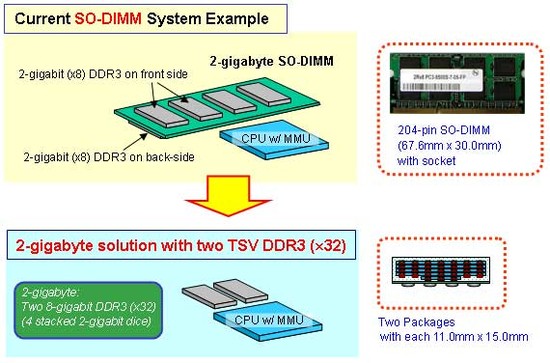SO-DIMM is the standard that most notebooks use to minimize the size and energy consumption of the RAM, but as we see thinner and thinner computers, but also tablets the need for alternatives grows bigger. With the help of TSV stacking technology Elpida has a solution that allows companies to solder a single memory circuit and allow it to act as a SO-DIMM.
TSV (Through Silicon Via) is a technology that allows Elpida to package several circuits on top of each other, also refered to as 3D stacking. Elpida says that unlike similar technologies TSV doesn’t need as long lanes in semiconductors, which means higher frequencies, lower energy consumption and large space savings in various designs.
It has glued together eight 1 Gigabit circuits on top of each other to get a single circuit to represent a SO-DIMM memory. This 8 Gigabit (1 Gigabyte) DDR3 SDRAM consumes 20% less during load and only 50% at idle, compared to a regular SO-DIMM memory. The circuits has an I/O configuration at 32-bit, which means that a processor with 64-bit or 128-bit memory bus would need two or four of these circuits for optimal bandwidth.

A SO-DIMM at 2 GB vs. Elpida’s soliution at 2 GB.
The major advantage is that you can eliminate the need for a SO-DIMM entirely and just solder the circuit onto the motherboard. Elpida hopes that the technology will make it to tablets, thin notebooks and other mobile solutions. We definitely see a need with products like MacBook Air or Intel’s Ultrabook that would serve Elpida’s TSV well, but then it would be hard or even impossible for the end-user to improve the memory.
Source: Elpida















